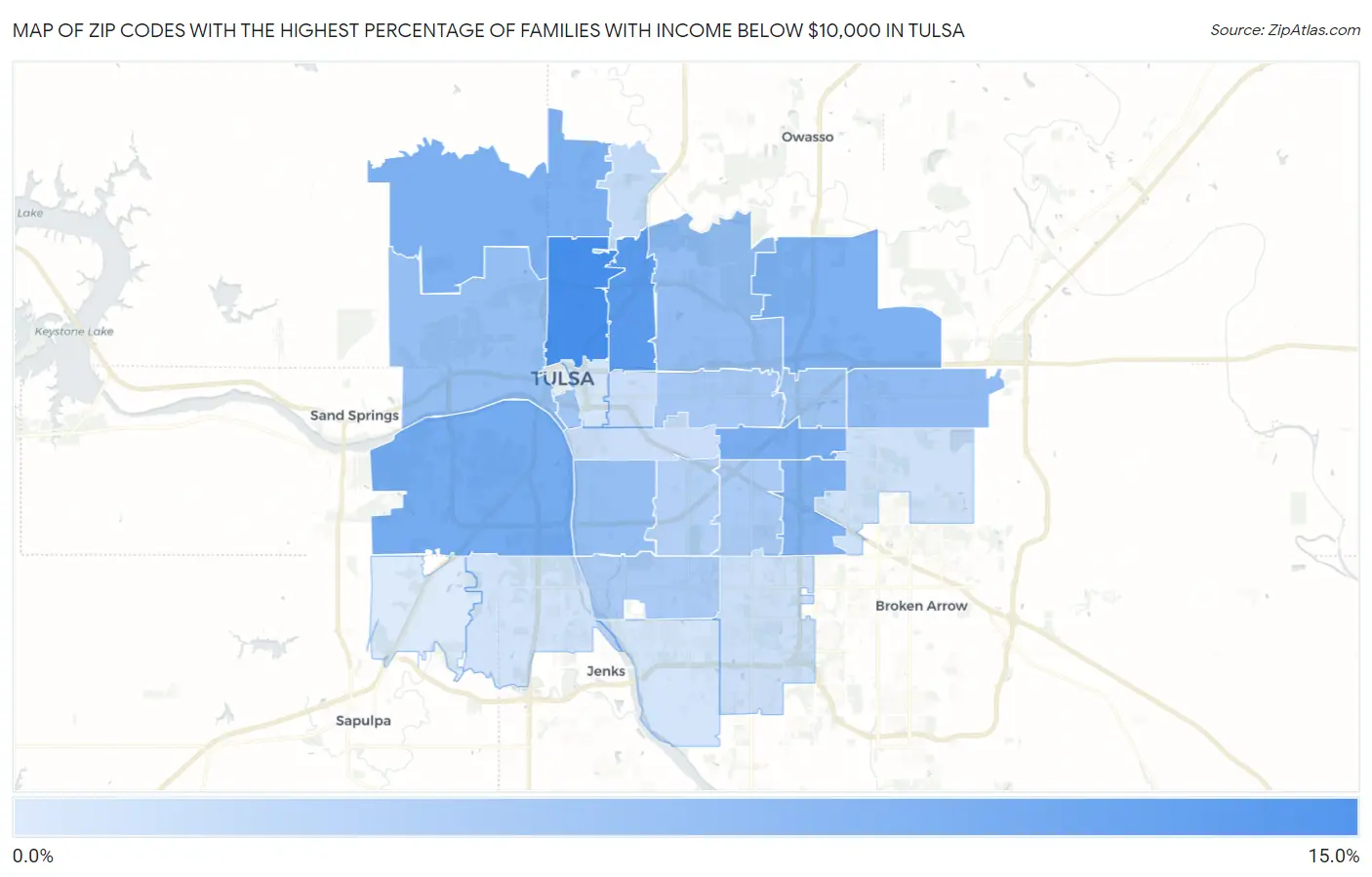Zip Codes with the Highest Percentage of Families with Income Below $10,000 in Tulsa, OK
RELATED REPORTS & OPTIONS
Family Income | $0-10k
Tulsa
Compare Zip Codes
Map of Zip Codes with the Highest Percentage of Families with Income Below $10,000 in Tulsa
0.80%
13.2%

Zip Codes with the Highest Percentage of Families with Income Below $10,000 in Tulsa, OK
| Zip Code | Families with Income < $10k | vs State | vs National | |
| 1. | 74106 | 13.2% | 3.8%(+9.40)#22 | 3.1%(+10.1)#1,087 |
| 2. | 74110 | 11.4% | 3.8%(+7.60)#29 | 3.1%(+8.30)#1,475 |
| 3. | 74107 | 9.2% | 3.8%(+5.40)#44 | 3.1%(+6.10)#2,248 |
| 4. | 74129 | 8.9% | 3.8%(+5.10)#48 | 3.1%(+5.80)#2,405 |
| 5. | 74126 | 8.7% | 3.8%(+4.90)#52 | 3.1%(+5.60)#2,514 |
| 6. | 74116 | 8.5% | 3.8%(+4.70)#58 | 3.1%(+5.40)#2,661 |
| 7. | 74146 | 8.2% | 3.8%(+4.40)#65 | 3.1%(+5.10)#2,850 |
| 8. | 74108 | 6.9% | 3.8%(+3.10)#88 | 3.1%(+3.80)#3,722 |
| 9. | 74115 | 6.8% | 3.8%(+3.00)#89 | 3.1%(+3.70)#3,804 |
| 10. | 74127 | 6.6% | 3.8%(+2.80)#95 | 3.1%(+3.50)#4,008 |
| 11. | 74105 | 6.5% | 3.8%(+2.70)#98 | 3.1%(+3.40)#4,107 |
| 12. | 74128 | 5.7% | 3.8%(+1.90)#126 | 3.1%(+2.60)#5,046 |
| 13. | 74119 | 5.5% | 3.8%(+1.70)#138 | 3.1%(+2.40)#5,374 |
| 14. | 74112 | 5.3% | 3.8%(+1.50)#144 | 3.1%(+2.20)#5,619 |
| 15. | 74136 | 4.8% | 3.8%(+1.00)#173 | 3.1%(+1.70)#6,432 |
| 16. | 74145 | 4.8% | 3.8%(+1.00)#175 | 3.1%(+1.70)#6,469 |
| 17. | 74135 | 4.0% | 3.8%(+0.200)#234 | 3.1%(+0.900)#8,185 |
| 18. | 74130 | 2.8% | 3.8%(-1.00)#338 | 3.1%(-0.300)#12,080 |
| 19. | 74104 | 2.3% | 3.8%(-1.50)#381 | 3.1%(-0.800)#14,050 |
| 20. | 74114 | 2.2% | 3.8%(-1.60)#388 | 3.1%(-0.900)#14,444 |
| 21. | 74133 | 2.0% | 3.8%(-1.80)#407 | 3.1%(-1.10)#15,258 |
| 22. | 74134 | 1.9% | 3.8%(-1.90)#424 | 3.1%(-1.20)#15,842 |
| 23. | 74132 | 1.7% | 3.8%(-2.10)#437 | 3.1%(-1.40)#16,875 |
| 24. | 74137 | 1.5% | 3.8%(-2.30)#451 | 3.1%(-1.60)#17,741 |
| 25. | 74120 | 1.3% | 3.8%(-2.50)#473 | 3.1%(-1.80)#18,963 |
| 26. | 74131 | 0.80% | 3.8%(-3.00)#503 | 3.1%(-2.30)#21,509 |
1
Common Questions
What are the Top 10 Zip Codes with the Highest Percentage of Families with Income Below $10,000 in Tulsa, OK?
Top 10 Zip Codes with the Highest Percentage of Families with Income Below $10,000 in Tulsa, OK are:
What zip code has the Highest Percentage of Families with Income Below $10,000 in Tulsa, OK?
74106 has the Highest Percentage of Families with Income Below $10,000 in Tulsa, OK with 13.2%.
What is the Percentage of Families with Income Below $10,000 in Tulsa, OK?
Percentage of Families with Income Below $10,000 in Tulsa is 5.4%.
What is the Percentage of Families with Income Below $10,000 in Oklahoma?
Percentage of Families with Income Below $10,000 in Oklahoma is 3.8%.
What is the Percentage of Families with Income Below $10,000 in the United States?
Percentage of Families with Income Below $10,000 in the United States is 3.1%.